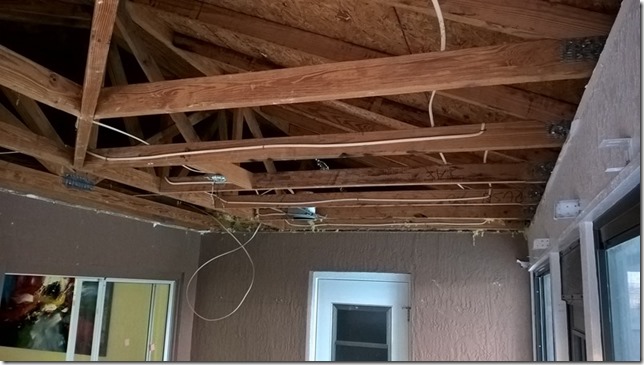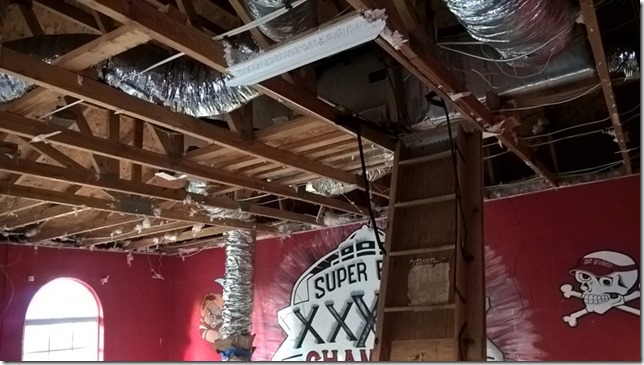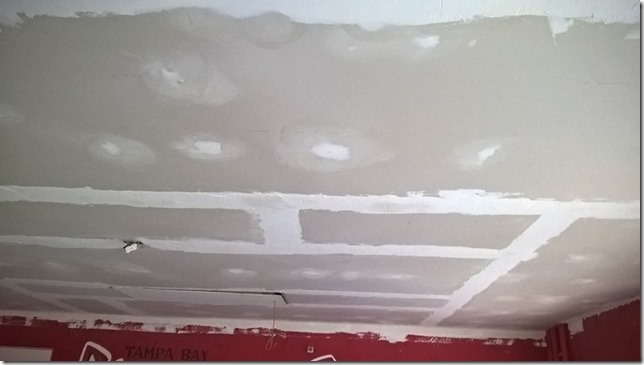In two rooms, I have some ceiling issues. In the lanai, a part of the ceiling is sagging and in the garage/game room, the ceiling has sustained water damage from a time when the A/C leaked. These are not projects I could manage on my own; I know my limitations. So I called a few handymen for quotes. Surprisingly, only one guy actually made it to the house to provide a quote. He seemed friendly and knowledgeable and since he kind of won by default, that who got the job.
As we talked about the repair, I also said I wasn’t concerned about the texture – knockdown in the lanai and popcorn in the garage. He said if I wanted to remove it, he could do it. That led to the decision that it would be cheaper and less labor-intensive to tear down the whole ceiling instead of trying to sand down any texture. Ok. You’re the one that knows. So I got a quote to replace two ceilings for $4k.
Day 1 – demo day. I get home from work and the whole lanai ceiling is down. Not bad. The crew is getting ready to take down the garage ceiling. Their plan is to climb in the attic and stomp it all down. That’s fine, but guys, shouldn’t you take out the florescent bulbs from the light fixtures first? Oh yeah, good call.
I leave them to their work and only a couple times heard “Whoa whoa whoa!” After the dust mostly settled, I went back in to see how it was. It was a mess. But one thing very quickly caught my eye. There were electrical runs from the breaker box to the far wall using unshielded wires, spliced together with wire nuts. I’m no electrician, but I can tell when something is unsafe and not up to building code. I grab my voltage tester and sure enough, the wires were live. It’s lucky the demo didn’t cause any shocks or start a fire. So that’s the first out of scope update that needs done.



Day 2 – Cleanup, wiring, and ductwork. While the ceiling was down, I made the decision to eliminate the a/c runs in the room in preparation of converting the room back to a garage. I asked them to seal off those runs, which they did. Now the room is hot, like a normal Florida garage in August. The crew installed junction boxes for light fixtures and ran new wiring for the outlets.
Day 3 – Wiring and initial drywall. The electrical boxes and conduit are installed and the wires are run for power. A few sheets of drywall are up now. The crew is gone by the time I get home today. I’ll give them credit, they clean the workspace up before they leave each day. And somehow, they fixed my door? It used to stick badly and now it doesn’t.

Day 15 – Everything is done and paid for. There is still some drywall that needs to be picked up when it isn’t pouring rain, but in effect, the job is done.
You can see I sort of blacked out between day 3 and 15. The days just went on and on with no end in sight. The boards would go up, then come down and be put up again. Then they would get seamed and fail review, so they’d need redone again. Then sanding and painting and fail and redo again. I guess I need to be grateful that the project manager was a stickler for quality, but it really needed to be done quicker and done right the first time. At the end, I didn’t care so much about how it looked, I just wanted them out of my house.



I say this project took 15 days. That’s 15 work days. It actually took 21 calendar days. And in that time, I had over a dozen different people in and out of my house. Because some crews sucked, they needed replaced, so more people came in to fix their mistakes. I expected a crew of maybe 4 people to come in and knock it out in a week. I got a different crew for demo, dry wall installation, seaming, finishing, and painting.
In the confusion, I am pretty sure I lost an electrical extension cord and some painting supplies. On the other end, I think my neighbor took advantage of the piles of trash that were left outside and I gained a car tire. I’m pretty sure he threw out a bunch of other construction waste in my piles, but that was hauled to the dump at the end of the project. They didn’t take the florescent bulbs.
Because of the craziness and the weather, I haven’t even really had a chance to take in the changes. I have to install lights and then begin cleaning and painting. This project should have been done so long ago and it’s only partially complete.
The next day I was able to take stock. I lost an extension cord, a push broom, paint tray, tray liners, the blower attachment for my air compressor, almost all my paint primer, and all 3 of my measuring tapes. That’s not even the worst part. The insulation they blew in is off-gassing an ammonia smell. Research says that will go away in up to 4 days, some have said 3-4 weeks. My garage has a ridiculous amount of water in the carpet and reeks of mildew.




























